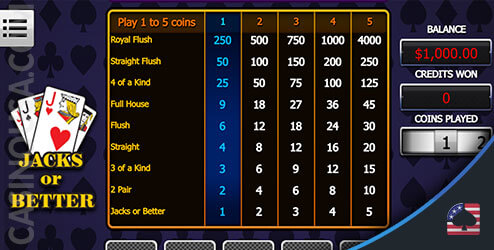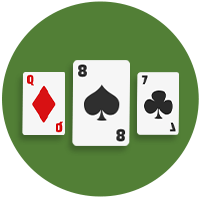- Slots
- Blackjack
- Roulette
- Live Dealer
- Baccarat
- Great selection of slots
- High-quality live dealer games
- Excellent welcome bonus
- Crypto-friendly
Betonline.ag
- Slots
- Blackjack
- Roulette
- Live Dealer
- Baccarat
- Licensed in Panama
- Great brand reputation
- Multiple gaming options
- Wide range of payment methods
- Slots
- Blackjack
- Roulette
- Live Dealer
- Baccarat
- 300+ games
- Crypto-friendly casino
- Live dealer jackpot
- Bonus galore for different verticals

However, this is only the case if you’re using the optimal strategy. But what is the optimal strategy really? Its name suggests it’s the best one to use, but how does it work, and what does it entail? Let’s see.
Understanding Poker Hand Rankings and Paytable
Every video poker game has its own paytable, while the hand rankings are pretty much the same, as they primarily come from regular poker.
To make things simpler, we’ll focus on a typical paytable for a 9/6 Jacks or Better game. It’s the highest-paying version and the one you should opt for if you want to utilize the optimal strategy to the max.
Here’s a simple table ranking hands from best to worst:
| Hand | Example | Description | Typical payout |
|---|---|---|---|
| Royal flush | 10♠️ J♠️ Q♠️ K♠️ A♠️ | A high straight in the same suit | 800 |
| Straight flush | 2♠️ 3♠️ 4♠️ 5♠️ 6♠️ | Any 5-card straight of the same suit | 50 |
| Four of a kind | 7♠️ 7♣️ 7♥️ 7♦️ | Four same-value cards | 25 |
| Full house | 10♠️ 10♦️ 3♣️ 3♠️ 3♥️ | Three of a kind and a pair | 9 |
| Flush | 3♠️ 6♠️ 7♠️ J♠️ A♠️ | Five same-suit cards | 6 |
| Straight | 7♠️ 8♥️ 9♣️ 10♠️ J♦️ | Five cards in consecutive order | 4 |
| Three of a kind | J♠️ J♣️ J♦️ | Three same-value cards | 3 |
| Two pair | 4♠️ 4♣️ 9♥️ 9♠️ | Two sets of same-value pairs | 2 |
| Jacks or better | J♠️ J♦️ | A pair of jacks or better (queens, kings, or aces) | 1 |
Below is an example of how this paytable looks in a Jacks or Better game:

Jacks or Better Strategy Tips — Which Moves to Make
Using the optimal strategy is quite simple. Below, you will find a specific list of moves you should make. It is important to consult it with every dealt hand to see which cards to keep.
The list ranks the hands from best to worst. Make sure to read through it until you’ve found a match for your hand. Once you get to it, keep the cards described, and discard the rest. The game will draw new ones instead, and you’ll see if you’ve won.
If you have nothing from the list, discard all the cards.
The important thing to understand is that this strategy leads to the best possible results, but a win is not guaranteed. Here’s the list:
- Royal flush
- Straight flush
- Four of a kind
- Four cards leading to a royal flush
- Full house
- Flush
- Three of a kind
- Straight
- Four cards leading to a straight flush
- Two pairs
- High-card pair
- Three cards leading to a royal flush
- Four cards leading to a flush
- Unsuited 10, jack, queen, and king
- Low-card pair
- Four cards leading to an outside straight, of which none, one, or two are high cards
- Three cards leading to a straight flush, where the number of high cards is the same or higher than the number of missing cards
- Suited jack and queen
- Four cards leading to an inside straight, where all cards are high
- Suited king and queen or king and jack
- Suited ace and king, ace and queen, or ace and jack
- Four cards leading to an inside straight, where three cards are high
- Three cards leading to a straight flush, where you have one gap and no high cards, or two gaps and one high card, or a low ace, or a 2, 3, and a 4
- Unsuited jack, queen, and king
- Unsuited jack and queen
- Suited 10 and jack
- Two unsuited high cards where the king is the highest
- Suited 10 and queen
- Two unsuited high cards where the ace is the highest
- One jack
- Suited 10 and king
- One queen
- One king
- One ace
- Three cards leading to a straight flush, where you have two gaps and no high card
We have provided explanations for the terms on the list you might not understand:
- High card — An ace, king, queen, or jack;
- Low card — All cards with numbers;
- Inside straight — An incomplete straight that needs a card on one end or the other, like 5, 6, 7, 8. You only need a 4 or a 9 to complete it.
- Outside straight — An incomplete straight that needs a card somewhere inside, like a 5, 6, 8, 9. You only need a 7 for the straight.
Here’s an example to help you comprehend how this works.
Let’s say you start a Jacks or Better game and you get the following hand — 5♠️ 9♥️ A♠️ J♠️ 6♦️. Looking at the list, the best thing you have here is A♠️ J♠️, which you’ll find under number 21. Keep these two, and you’ll have a decent chance of getting another ace or jack — maybe even something better.
Let’s look at a different hand — 10♥️ 7♠️ 9♠️ 10♦️ 8♣️. The two 10s are the best combination here, as that’s a low pair you can find under number 15 in our list. A low pair is a good hand since it has a potential to turn into three of a kind or better.
Hands You Never Play
There are a few hands that might seem to deserve a place on our list, but they should actually be avoided. Here’s what you should do in case you get them:
If you get four cards leading to an inside straight where none are high, discard all cards.
If you get four cards leading to an inside straight where one is high, keep the high card only.
If you get four cards leading to an inside straight where two are high, keep the high cards only.
If you get a suited ace and 10, only keep the ace.
If you get three unsuited high cards where the ace is the highest, only keep the other two cards.
Low- and High-Pair Strategy

It can be confusing for players to know when to keep a high pair and when to keep a low one. This depends on the situation.
Namely, when it comes to low card pairs, it’s usually good to keep all of them. However, there are a few instances when you should do the opposite. Here’s what you need to do when you have other combinations with a low pair:
- Keep the low pair if you get four cards leading to a straight.
- Keep the low pair if you get two cards leading to a royal flush.
- Keep the low pair in case you have three cards leading to a straight flush.
- Discard the low pair in case you have four cards leading to a flush.
- Discard the low pair in case you have three cards leading to a royal flush.
On the other hand, you should always keep a high pair when you get it because this is a win in Jacks or Better.
Still, there is one exception to the rule — when you get four cards leading to a royal flush. You might end up not winning a royal flush, but the opportunity to score the highest-paying hand in video poker is just too good to pass for a sure high-pair win that pays only double.
Conclusion
The optimal strategy for Jacks or Better is the only strategy a video poker player should use, as it pays the most and is simple to grasp. With the help of this guide, you are bound to win more than you usually do.
FAQ
- Aces and Eights
- Aces and Faces
- Bonus Poker
- Bonus Poker Strategy
- Common Mistakes
- Deuces Wild
- Double Bonus Poker
- Double Double Bonus Poker
- Full Pay Video Poker
- Full vs. Short Pay
- How To Win
- Jacks or Better
- Joker Poker
- Joker Poker Strategy
- Land-Based vs. Online
- Single vs. Multi-Hand
- Strategy Charts
- Tens or Better
- Tens or Better Strategy
- Video Poker Pay Tables
- Video Poker vs. Slots
- Video Poker vs. Table Poker



